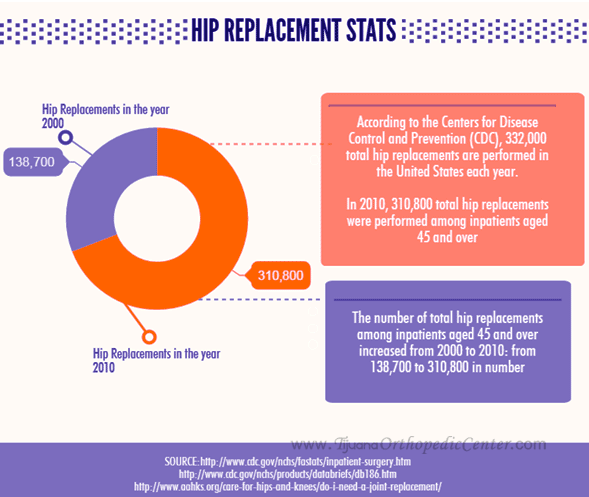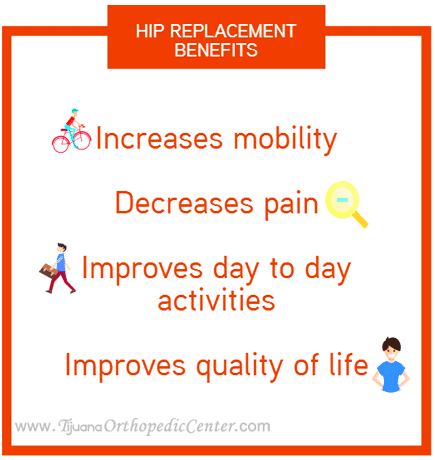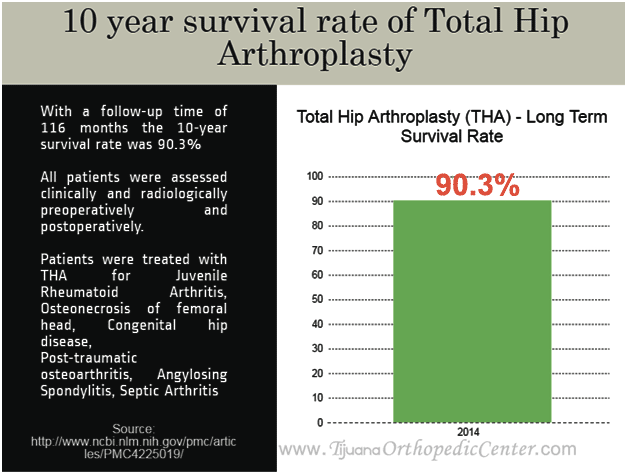Hip Replacement
Those beleaguered by debilitating hip pain and the high cost of surgery in their home country can heave a sigh of relief with affordable surgery in the Mexican border city. Ortho experts here apply state-of-the-art technology to ease your hip pain.
Hip Replacement Package for Tijuana – $10,500 only*
*Cost of hip replacement on one side. Does not include X-ray or MRI cost
The website may not reflect the latest prices. We recommend you get in touch with us via the quote-form for the latest prices and discounts.
Hip replacement is performed by a highly eminent bone and joint surgeon at his state-of-the-art orthopedic hospital in Tijuana.
What is Hip Replacement?
- Alternatively known as hip arthroplasty, hip replacement is a procedure which involves surgically replacing diseased or damaged bones and cartilages of the hip with prosthetics.
- It can either be total or partial hip replacement.
- It is performed to get relief from arthritic pain or to treat hip fractures.
- During surgery, your orthopedic surgeon will remove the damaged femoral head; a metal stem will be positioned inside the hollow part of the femur.
- A prosthetic ball made of metal or ceramic will be attached to the upper part of the stem; this ball will take place of the removed femoral head.
- A metal socket will replace the damaged socket known as acetabulum.
- To ensure a smooth gliding surface, a liner made of either plastic, metal or ceramic may be placed between the prosthetic ball and the artificial femoral head.
- In partial hip replacement (hip hemiarthroplasty), only the damaged ball of the hip joint is replaced with a prosthetic.

According to the Centers for Disease Control and Prevention (CDC), 332,000 total hip replacements are performed in the United States each year1. Over 310,800 total hip replacements were performed on patients aged 45 and over in 2010.
The number of total hip replacements among inpatients aged 45 and over increased from 2000 to 2010 from 138,700 to 310,8002.
According to the American Association of Hip and Knee Surgeons (AAHKS), there may be a need for 500,000 hip replacements each year by 2030.
Benefits of Hip Replacement
According to a published study in 2015 by Ganeshan GR and Varthi VP, hip replacement surgery increasing mobility, improves the hip joint function, relieves pain and improves life quality3.
Causes of Hip Pain
Some of the common causes of hip pain are:
- Osteoarthritis: A common occurrence in individuals aged 50 or over, osteoarthritis is a condition in which the cartilage providing cushion to bones wears down and causes the bones to rub against each other. This results in pain and discomfort.
- Spurs: Growth of damaged bones (spurs) may also result in pain and stiffness.
- Rhuematoid Arthtritis: It leads to chronic inflammation in the bone joints which results in pain and stiffness.
- Osteonecrosis: Dislocation, fracture, or any other injury to the bone which limits blood supply to the femoral head may cause the bone surface to give away. As a result arthritis sets in.
- Hip Problems from Childhood: Sometimes hip problems treated in childhood may manifest themselves as arthritis in adulthood. This may be a result of improper growth of bones and joint surfaces later.
When is Hip Replacement Recommended?
Your surgeon may recommend hip replacement if you have:
- Hip pain that interferes with daily activities
- Hip pain that lingers on even while you rest
- Rigidity in hips that restricts your leg movement
- Unsatisfactory respite from anti-inflammation medications, physiotherapy, or support for mobility
What happens during initial consultation?
Your consultation for hip replacement at Tijuana Orthopedic Center (TOC) involves the surgeon reviewing the results of your evaluation and discussing whether hip replacement surgery is best suited for you or not.
Will there be any relief in my hip pain post-operatively?
According to a study published in the year 2013 by G. A. McHugh and colleagues, 206 Hip Arthroplasty patients were treated and following points were noted:
- Pain, stiffness and physical function all improved significantly from pre-operative at 12-month assessment5.
- The study states there was significant improvement in pain levels.
What is long term survival rate of THA?
A 2014 study by Pakos et al states excellent patient function after 116 months6. A survival curve of 90.3% was reported after 10 years6. The patients were assessed clinically and radiologically pre- and post-operatively.
The main indication for Total Hip Arthroplasty (THA) was juvenile rheumatoid arthritis (19 hips, 42.2%), followed by osteonecrosis of the femoral head (11 hips, 24.4%) and congenital hip disease (5 hips, 11.1%).
No patient developed any immediate postoperative complication during the hospitalization6.
Do I need to undergo any tests?
An orthopedic evaluation will be conducted which includes:
- Medical Evaluation: To ascertain the extent of your hip pain, the surgeon might ask questions regarding the problems faced by you for doing the daily activities, like bending and walking. Patients with unceasing medical conditions may be assessed by a specialist before the surgery.
- X-Rays: They are done to evaluate the deformity of your hip (if any).
- Urinary Evaluation: Before going ahead with the surgery, the surgeon may ask you for a complete urological evaluation, especially if you have a history of urinary infections.
- BMI: According to a latest study published in April 2016, Eddie S. Wu and colleagues’ state patients with high BMI are at increased risk of complications including dislocation, infection and prolonged hospital stay4. The American Association of Hip and Knee Surgeons recommended that patients with a BMI greater than 40 kg/m2 be encouraged to undergo a weight-loss program prior to THA.
Will I require rehabilitation therapy post surgery?
Yes, almost all patients require some form of light exercises after surgery. Your physical therapist and surgeon will guide you regarding the same.
Movement is an essential part of your recovery. Most patients who undergo total hip replacement begin standing and walking with the help of a walking support and their physical therapist the day after surgery. Your therapist will guide you to strengthen your hip movements by way of walking and exercising.
Surgery Schedule
- Arrival: 1 day prior to surgery
- Stay at Surgery Center: 3 nights after the surgery
- Hotel Stay (recommended): 1-2 days in Tijuana for follow-up
Total number of days required: 5-6 days
What happens after hip arthroplasty?
When the anesthesia wears off, you will feel some pain. The medical staff present at TOC will make sure you feel as comfortable as possible. Pain management is an important part of your recovery.
Diet
A balanced diet accompanied with an iron supplement to promote tissue healing is recommended. Don’t dehydrate yourself; be sure to drink plenty of liquids.
Wound Care
You may have stitches running along your wound which will be removed roughly after 2 weeks of the hip replacement surgery. Bandage the wound to prevent irritation from clothing and avoid getting the wound wet until it dries entirely.
Activity
Exercise is a critical element of home care but make sure you don’t indulge in a heavy exercise routine. Keep your exercises light and regular.
Inform TOC without more ado if you develop any of the following signs of a possible hip replacement infection:
- Any discharge from the hip wound
- Constant fever (higher than 100°F)
- Increasing hip pain with any kind of activity
- Increasing redness, or swelling of the hip wound
What are the things that I should avoid?
Avoiding slipping/falling
A fall can damage your new hip and result in dire consequences. Make use of a cane, crutches or a walker until you improve your sense of balance and strength.
Other Precautions
To prevent dislocation of the new hip bone/prosthesis, you may be asked to take special precautions when sitting, bending, or sleeping for 6-8 weeks after surgery.
Preparing Your Home for Surgery
You will have to make some changes to your home for better navigation after your hip replacement surgery, such as the following:
- Toilet grab bars and safety handrails in showers
- Fall-prevention stairway handrails
- Stable armchair (allowing your hips to be at a higher level than your knees)
- Raised toilet seat and a bench for bathing
- A grabber that allows you to get hold of objects without straining your hips
- Get rid of loose carpets and electrical wires to avoid tripping over them
Having Your Surgery in Tijuana
Your hip replacement procedure will be performed by a leading orthopedic surgeon in Tijuana with vast experience. Having helped thousands of people get rid of orthopedic troubles over a span of thirty years, Dr. Eliseo Mora Sanchez is a top bone and joint specialist in Mexico.
By having your hip replacement in Tij, you get to enjoy the following benefits:
- Save immensely – Our package costs are substantially lower than prices charged in the United States and Canada.
- Cut down traveling – The Mexican border city can be conveniently reached by residents of California and Arizona because of proximity.
- Value-added Services – Enjoy a host of services including:
- Trip planning
- FREE ground transfers
- On-location 24*7 support
- Hotel bookings
- Medical loan assistance
- Travel documentation assistance
Contact us through the quote-form on the website for more information and a FREE estimate on hip replacement.
References:
- http://www.cdc.gov/nchs/fastats/inpatient-surgery.htm
- http://www.cdc.gov/nchs/products/databriefs/db186.htm
- Ganesan GR, Varthi VP. Is dislocation rate higher in total hip arthroplasty done for acute displaced fracture neck of femur?. J Orthop Allied Sci 2015;3:59-62. http://www.joas.in/article.asp?issn=2319-2585;year=2015;volume=3;issue=2;spage=59;epage=62;aulast=Ganesan
- Wu E, Cherian J, Jauregui J, Robinson K, Harwin S, Mont M. Patient-Reported Outcomes Following Total Hip Arthroplasty Stratified by Body Mass Index.2016; 39: e572-e577. doi: 10.3928/01477447-20160404-09. http://www.healio.com/orthopedics/journals/ortho/2016-5-39-3/%7B6f694f72-805a-44ba-b1b4-bdfb8babc84d%7D/patient-reported-outcomes-following-total-hip-arthroplasty-stratified-by-body-mass-index
- Predictors of outcomes of recovery following total hip replacement surgery. G. A. McHugh, M. Campbell, K. A. Luker. DOI: 10.1302/2046-3758.211.2000206 Published 27 November 2013. http://www.bjr.boneandjoint.org.uk/content/2/11/248
- Pakos EE, Paschos NK, Xenakis TA. Long Term Outcomes of Total Hip Arthroplasty in Young Patients under 30. Archives of Bone and Joint Surgery. 2014;2(3):157-162. http://www.ncbi.nlm.nih.gov/pmc/articles/PMC4225019/



